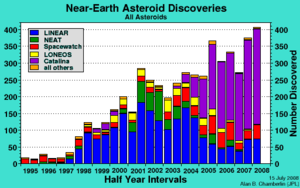
Spacewatch
Encyclopedia

University of Arizona
The University of Arizona is a land-grant and space-grant public institution of higher education and research located in Tucson, Arizona, United States. The University of Arizona was the first university in the state of Arizona, founded in 1885...
led by Robert S. McMillan
Robert S. McMillan
Robert S. McMillan is an astronomer at the University of Arizona, and heads the Spacewatch project, which studies minor planets. He has made various discoveries, including notably 20000 Varuna....
that specializes in the study of minor planet
Minor planet
An asteroid group or minor-planet group is a population of minor planets that have a share broadly similar orbits. Members are generally unrelated to each other, unlike in an asteroid family, which often results from the break-up of a single asteroid...
s, including various types of asteroid
Asteroid
Asteroids are a class of small Solar System bodies in orbit around the Sun. They have also been called planetoids, especially the larger ones...
s and comet
Comet
A comet is an icy small Solar System body that, when close enough to the Sun, displays a visible coma and sometimes also a tail. These phenomena are both due to the effects of solar radiation and the solar wind upon the nucleus of the comet...
s. It was founded in 1980 by Tom Gehrels
Tom Gehrels
Tom Gehrels , was an American astronomer, Professor Planetary Sciences, and Astronomer at the University of Arizona, Tucson....
and McMillan.
Notable discoveries
- CallirrhoeCallirrhoe (moon)Callirrhoe , also known as ' , is one of Jupiter's outermost named natural satellites. It is an irregular moon that orbits in a retrograde direction. Callirrhoe was imaged by Spacewatch at Kitt Peak National Observatory from October 6 through November 4, 1999, and originally designated as asteroid...
- 5145 Pholus5145 Pholus5145 Pholus is a centaur in an eccentric orbit, with a perihelion less than Saturn's and aphelion greater than Neptune's. Pholus has not come within one astronomical unit of a planet since 764 BC, and will not until 5290. It is believed that Pholus originated as a Kuiper belt object.It was...
- 9965 GNU9965 GNU9965 GNU is a C-type main belt asteroid. It orbits the Sun once every 3.76 years.Discovered on March 5, 1992 by Spacewatch, it was given the provisional designation "". It was later renamed "GNU" after the GNU project.- See also :...
- 9885 Linux9885 Linux9885 Linux is an asteroid discovered on October 12, 1994 by Spacewatch. The asteroid is named after the Linux operating system kernel.- See also :* 9793 Torvalds, an asteroid named after Linus Torvalds...
- 20000 Varuna20000 Varuna20000 Varuna is a large classical Kuiper belt object and a probable dwarf planet. It previously had the provisional designation ' and has been precovered in plates dating back to 1953.-Name:Varuna is named after the Hindu deity,...
- 60558 Echeclus60558 Echeclus60558 Echeclus is a centaur in the outer Solar System. It was discovered by Spacewatch in 2000 and initially classified as an asteroid with provisional designation . Research in 2001 by Rousselot and Petit at the Besançon observatory in France showed no evidence of cometary activity, but in late...
- 1994 CC
- C/1992 J1C/1992 J1C/1992 J1 is a comet that was discovered 1 May 1992 by David Rabinowitz of the Spacewatch Project. This was the first comet to be discovered using an automated system....
- 125P/Spacewatch
The project also recovered 719 Albert
719 Albert
719 Albert is a Mars-crossing, Amor asteroid; it was the second one discovered after 433 Eros.-Discovery:Discovered in 1911 by Johann Palisa, the asteroid was named after one of the Imperial Observatory in Vienna's major benefactors, Albert Salomon von Rothschild, who had died some months before...
, a long-lost asteroid.
See also
- Planetary Data SystemPlanetary Data SystemThe Planetary Data System is a distributed data system that NASA uses to archive data collected by Solar System robotic missions and ground-based support data associated with those missions. PDS is managed by NASA Headquarters' Planetary Sciences Division. The PDS is an active archive that makes...
(PDS) - Minor Planet CenterMinor Planet CenterThe Minor Planet Center operates at the Smithsonian Astrophysical Observatory , which is part of the Center for Astrophysics along with the Harvard College Observatory ....
- Catalina Sky SurveyCatalina Sky SurveyCatalina Sky Survey is a project to discover comets and asteroids, and to search for Near-Earth objects. More specifically, to search for potentially hazardous asteroids , that may pose a threat of impact.-Mission:...
- Near Earth Asteroid TrackingNear Earth Asteroid TrackingNear-Earth Asteroid Tracking is a program run by NASA and Jet Propulsion Laboratory to discover near-Earth objects. The NEAT project began in December 1995 and ran until April 2007.-History:...
(NEAT) - Lincoln Near-Earth Asteroid ResearchLincoln Near-Earth Asteroid ResearchThe Lincoln Near-Earth Asteroid Research project is a cooperative project between the United States Air Force, NASA, and MIT's Lincoln Laboratory for the systematic discovery and tracking of near-Earth asteroids. LINEAR was responsible for the majority of asteroid detections since 1998 until...
(LINEAR) - Lowell Observatory Near-Earth-Object SearchLowell Observatory Near-Earth-Object SearchLowell Observatory Near-Earth-Object Search ' was a project designed to discover asteroids and comets that orbit near the Earth. The project, funded by NASA, was directed by Dr. Ted Bowell of Lowell Observatory in Flagstaff, Arizona...
(LONEOS) - Pan-STARRSPan-STARRSThe Panoramic Survey Telescope and Rapid Response System is a planned array of astronomical cameras and telescopes and computing facility that will survey the sky on a continual basis, including accurate astrometry and photometry of detected objects...
- SpaceguardSpaceguardThe term Spaceguard loosely refers to a number of efforts to discover and study near-Earth objects . Asteroids are discovered by telescopes which repeatedly survey large areas of sky. Efforts which concentrate on discovering NEOs are considered part of the "Spaceguard Survey," regardless of which...

